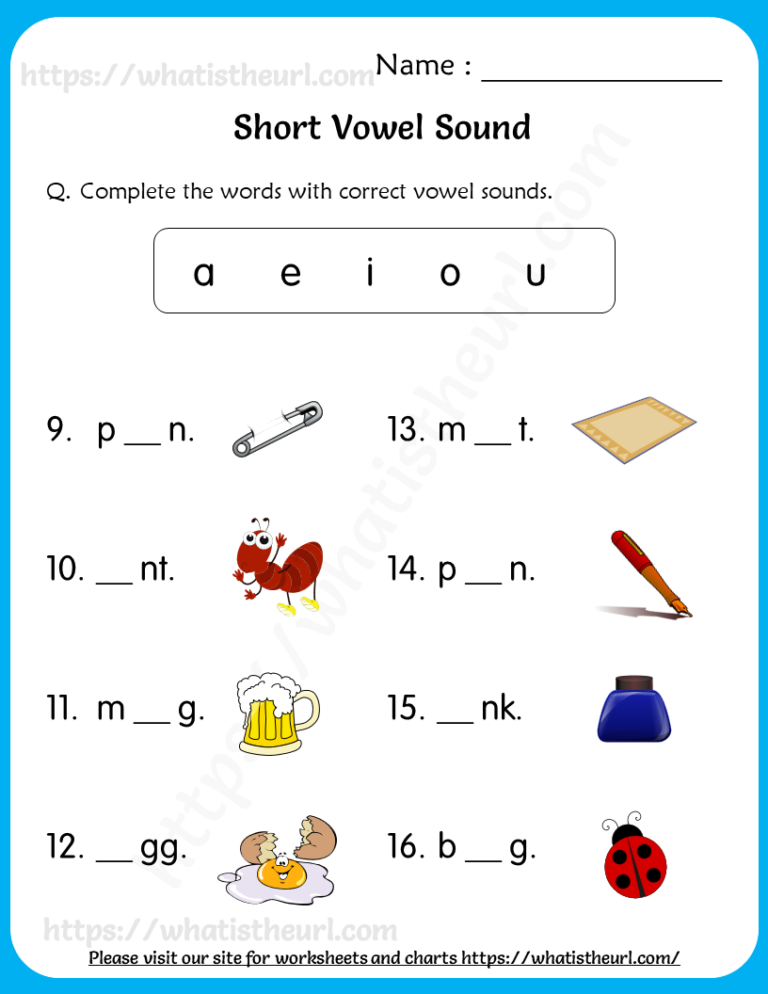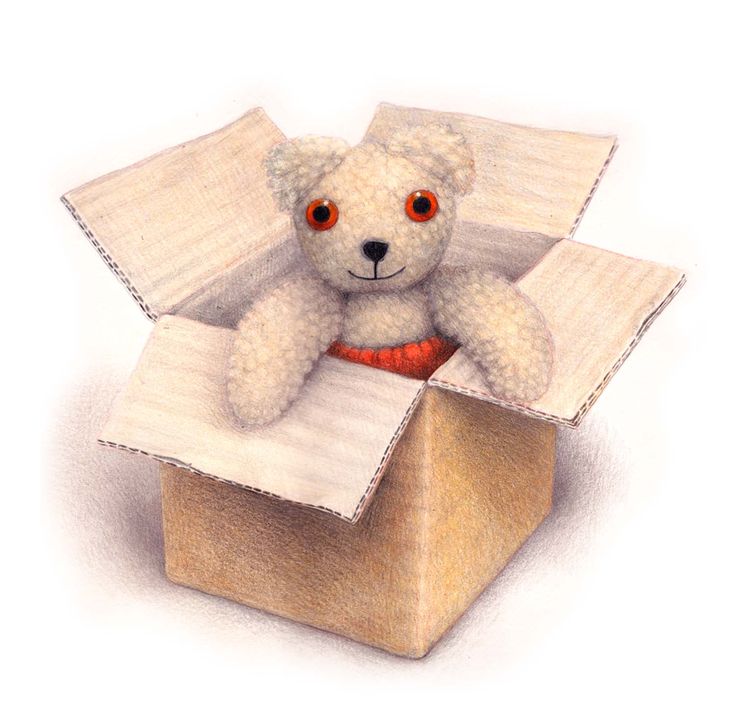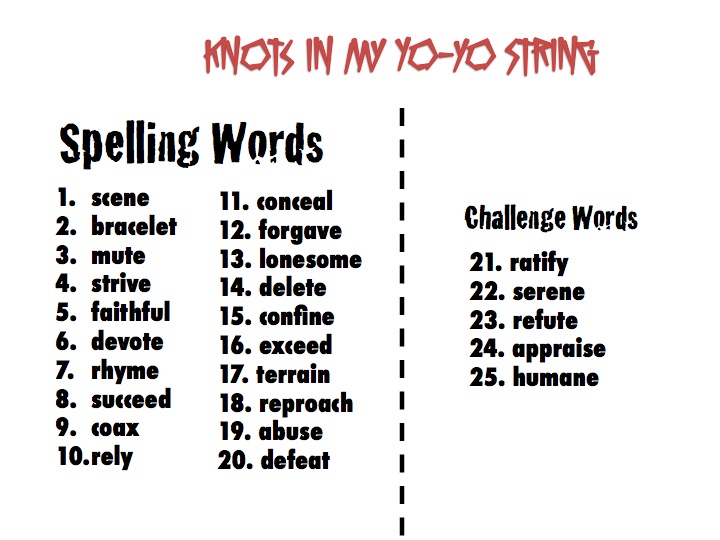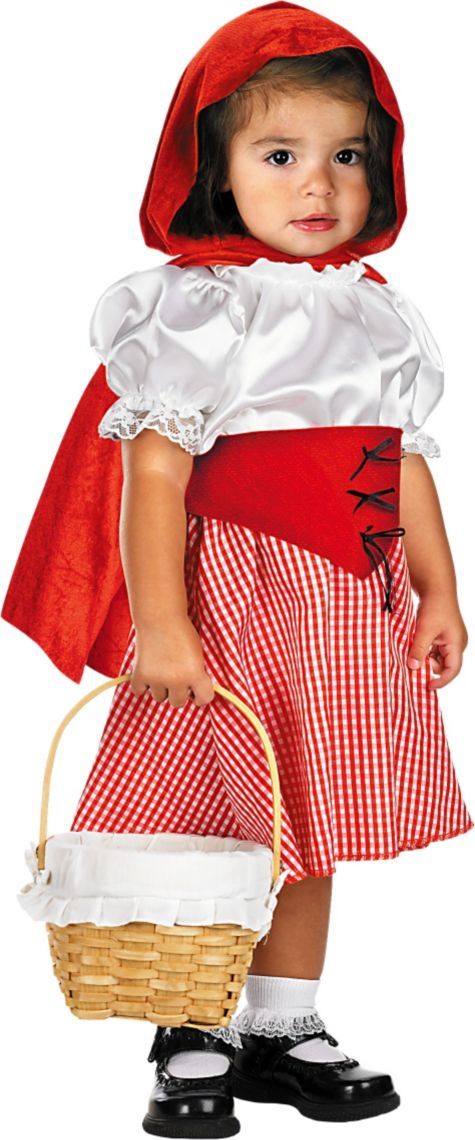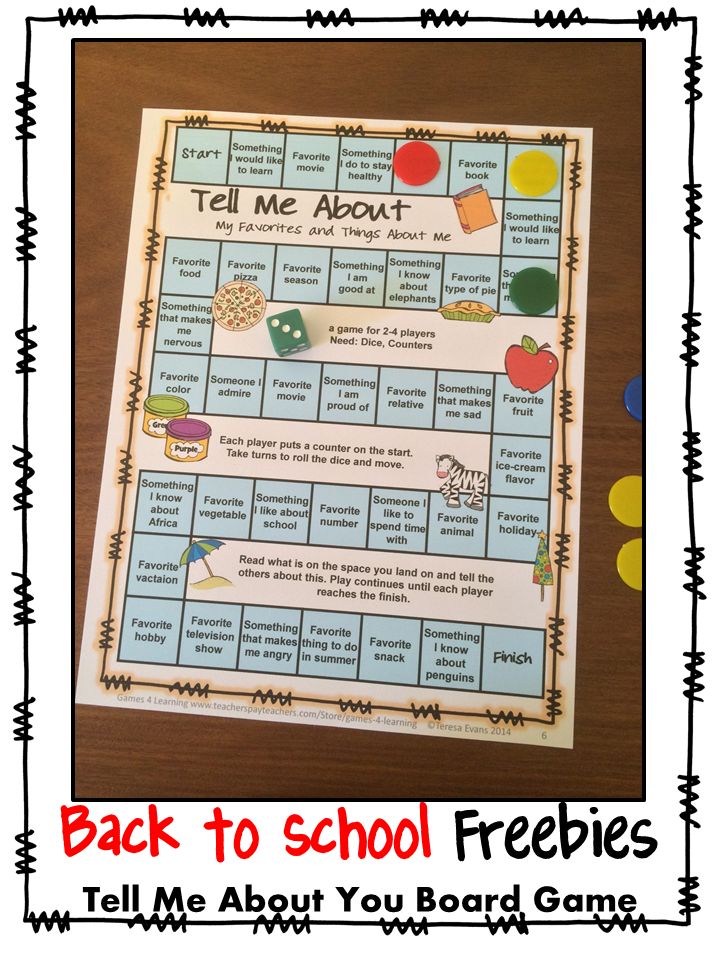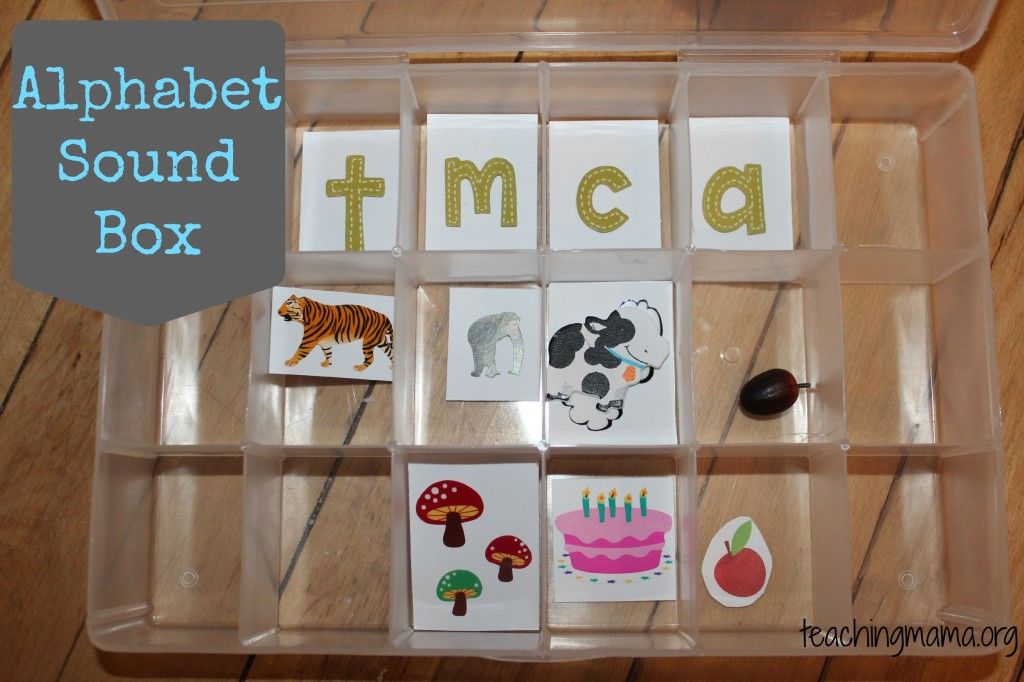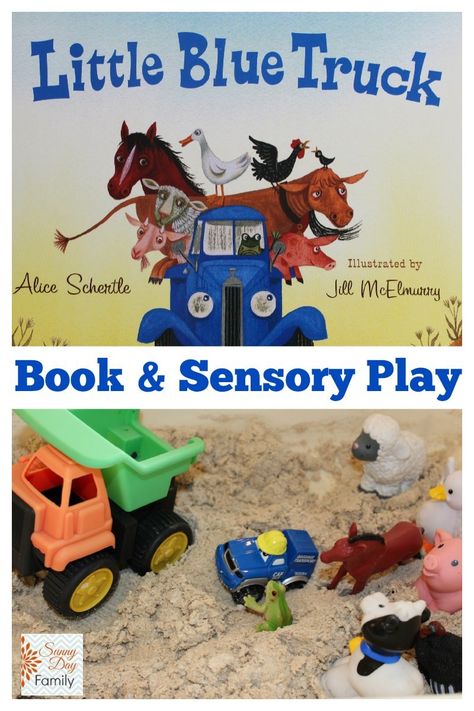Short vowels lesson
5 Easy Short Vowel Activities to Make Your Phonics Lesson POP! -
Let’s chat about 5 easy short vowel activities that will pop in your classroom. I know sometimes these short vowel lessons can get a little boring in the classroom. Do you ever get bored teaching short vowel lessons?
We’ve talked about teaching phonics explicitly during reading instruction…it’s important!
What is the Difference Between Short Vowels and Long Vowels?
After reading the article from Classroom, they sum it well, “As the name would imply, short vowels have a much shorter pronunciation than long vowel sounds.”
Short vowels will make a shorter sound, whereas long vowels have a longer sound, saying the vowels’ exact name. Long vowel sounds allow the speaker to move their mouth from a closed position to an open one.
When dealing with short vowels, it will be 1 vowel closed in by a consonant or consonants. Examples: man, wet, fish, tub, moth
Long vowels have many more complicated spelling patterns. There are vowel teams, the magic e, open syllables, and more!
What are the Short Vowels?
As Classroom states, “Short vowels produce only one sound and do not require the speaker to open his mouth very wide. The speaker’s jaw is relaxed and barely moves during the production of short vowel sounds. The speaker’s tongue is placed in different positions but is also usually relaxed. Short vowels can occur in stressed syllables, such as “o” in offer, or unstressed syllables, like the first “o” in tomato.”
As a former first-grade teacher and current reading specialist, I like to start the school year off by teaching the short vowel sounds. What are the short vowels? A, E, I, O, and U!
The vowels are closed in by a consonant or consonants to make the short vowel sound. Watch this video on my Instagram to see it in action! Read more to learn more about the 5 Easy Short Vowel Activities!
5 Easy Ways to Teach Short Vowels
Using a sand tray to practice letters and perfect to practice short vowels. An example of using a vowel intensive drill to practice short vowel sounds. Using a house to practice open and closed syllables.
An example of using a vowel intensive drill to practice short vowel sounds. Using a house to practice open and closed syllables. Let’s discuss 5 easy short vowel activities! These 5 ideas will help the students grasp the concept of short vowels while having fun!
- Add Movement! When you teach the short vowel sounds, incorporate a movement for each sound. For example, for the short a sound…students can place their hand under their chin to feel the movement. Multi-sensory techniques will help make more brain connections as the students these short vowel sounds.
- Closed Syllable Houses! Have the students make a little house with a door. Cut the door so it opens and closes. Laminate to reuse! Write CVC words onto the house to show how the consonant closes in the vowel and makes the vowel. This post will explain more about open and closed syllables! Here is my Instagram Reel that shows closed syllables in action.
- Sand Trays! Pour sensory sand or play sand onto a tray or plate.
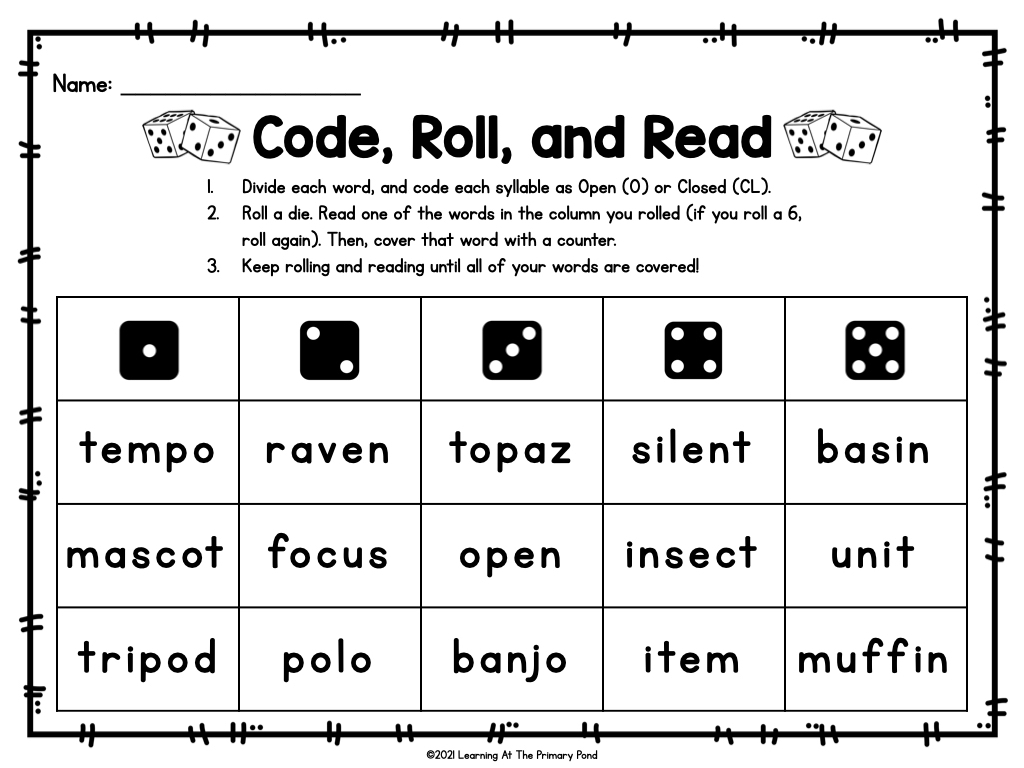 The teacher will say a sound, the students will write the corresponding vowel into the sand. Step it up by having the teacher say a word, the students will write the vowel into the sand.
The teacher will say a sound, the students will write the corresponding vowel into the sand. Step it up by having the teacher say a word, the students will write the vowel into the sand. - Vowel Intensive Drill: In Orton Gillingham, a wonderful way to practice the short vowel sounds is the vowel intensive drill. Each student will have the 5 vowels on separate notecards, in a little tent. See the photo below! The teacher will say a short vowel sound, the students will hold up the corresponding card. For example, if the teacher will say /ă/, the students will hold up the card. The students love this practice and it is a perfect multi-sensory activity.
- Use Visuals! Try out my teaching slideshow, “We Love Short Vowels”. It provides example words for each short vowel. The students can practice reading many words as they learn all about the short vowels. It also includes corresponding worksheets to practice each short vowel.
I hope you can incorporate some of the 5 Easy Short Vowel Activities in your own classroom.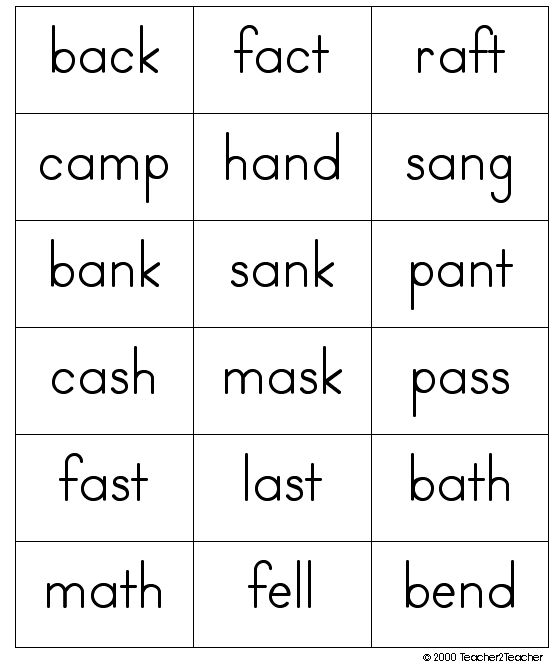
Can’t I Just Teach Word Families?
Years ago as a teacher, I would begin each school year teaching word families. To begin, I’m not saying word families can’t have a place in the classroom, but it can’t be the only way short vowels are taught. Use word families as a strategy to teach short vowels, but not the ONLY way!
All About Learning Press has an argument against relying solely on word families in your teaching.
“If you stop there—just teaching word lists grouped by word families—you will be severely disappointed in your teaching efforts.
Why? Because if you use word families incorrectly, students may end up just following the “pattern” of that particular lesson, blindly zipping through the spelling words without really learning them. What you intended to be educational and insightful becomes an exercise in following patterns—and the time you spent teaching spelling goes down the drain because your child can’t actually spell those words outside of the neatly organized list.
Another downfall of overemphasizing word families is the risk that your child will pay too much attention to the ends of words, skipping over the first part of the word to get to the answer. Instead, we want the student’s eye to start at the beginning of the word and move to the end of the word. Encouraging his eye to start at the end of the word and then jump back to the beginning of the word is reinforcing incorrect eye movement. We don’t want to reinforce dyslexic tendencies.”
“Use word families as a strategy to teach short vowels, but not the ONLY way!”
-RIndy Roberts, Learning with heart
By teaching the students to look from the beginning of a word to the end of a word, will be beneficial when they come to words with suffixes.
What about the science of reading?
I made a free guide for teachers and parents to make it easy to incorporate the Science of Reading with their students. The research behind the Science of Reading is so intriguing and I wanted to share how I incorporate it daily into my instruction.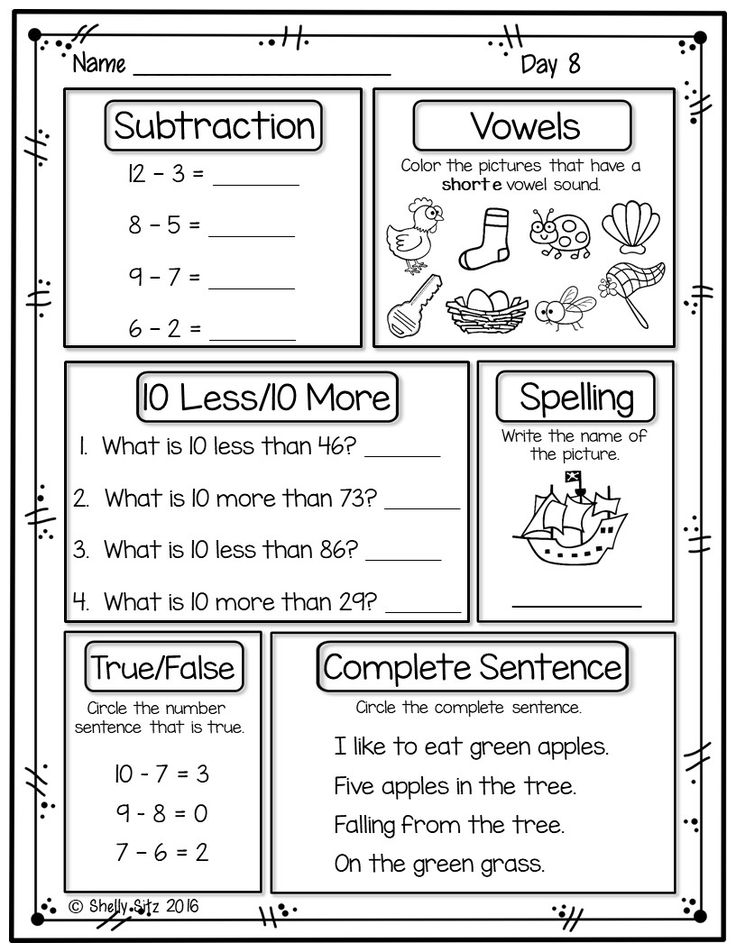
I wanted to make it SIMPLE for teachers to make this shift to teaching phonemic and decoding skills explicitly.
Short Vowels & The Science Reading?
The science of reading is key when you are teaching. First, based on much research, teaching phonics explicitly will benefit all children. According to Secret Stories, “Decoding is essential to reading. It allows kids to figure out most words they’ve heard but have never seen in print, as well as sound out words they’re not familiar with. The ability to decode is the foundation upon which all other reading instruction—fluency, vocabulary, reading comprehension, etc… are built.”
“Teaching phonics explicitly will benefit all children.”
The Orton Gillingham approach uses multi-sensory learning techniques to teach decoding, encoding, and blending sounds to build successful readers. Based on the Orton-Gillingham Academy, “The Orton-Gillingham Approach is a direct, explicit, multisensory, structured, sequential, diagnostic, and prescriptive way to teach literacy when reading, writing, and spelling does not come easily to individuals, such as those with dyslexia. It is most properly understood and practiced as an approach, not a method, program, or system. In the hands of a well-trained and experienced instructor, it is a powerful tool of exceptional breadth, depth, and flexibility.”
It is most properly understood and practiced as an approach, not a method, program, or system. In the hands of a well-trained and experienced instructor, it is a powerful tool of exceptional breadth, depth, and flexibility.”
I have been using the Orton Gillingham approach in my classroom for 3 years now. By using this multi-sensory learning approach, the students are more likely to grasp and retain what they learn. Read more about why I love Orton Gillingham here!
Orton Gillingham phonics program has made such a difference in my classroom. It is a multi-sensory phonics curriculum. In the first grade curriculum, it builds on the correct letter formation in handwriting and the sounds the letters make.
The Orton-Gillingham Approach is multi-sensory and structured to teach reading, writing, and spelling.
It is commonly used for students with dyslexia, but can be used to help all students feel more confident when they read and write!
Resources to Help With Short Vowels
I have created the “We Love Phonics” program to make it easier for teachers to introduce and teach phonics skills.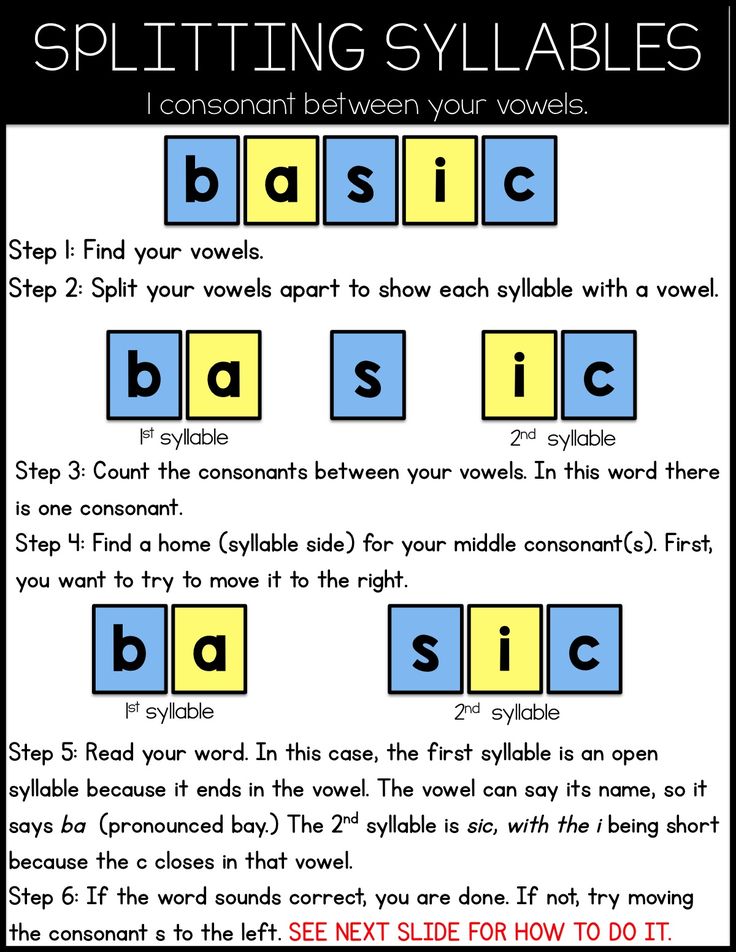 I have created a resource that will guide you for an entire school year, with lesson slideshows and worksheets that correspond to each skill.
I have created a resource that will guide you for an entire school year, with lesson slideshows and worksheets that correspond to each skill.
The short vowel resource will cover all 5 easy short vowel activities. The Open/Closed Syllable resource will explain how to break words into syllables, and the explanation of closed syllables with the short vowel sound. What are your favorite ways to teach short vowels?
This product will help with the steps to distinguish between open and closed syllables.Would you like the FREE Science of Reading Guide? Check out this FREEBIE!
Short Vowels and Long Vowels Lesson Plan
Objectives:
- Students will learn how to recognize and remember the sounds of both short vowels and long vowels.
- Students will be able to produce the sounds of the short vowels and long vowels in isolation.
About the Concept:
Vowels in the English language can represent a variety of sounds.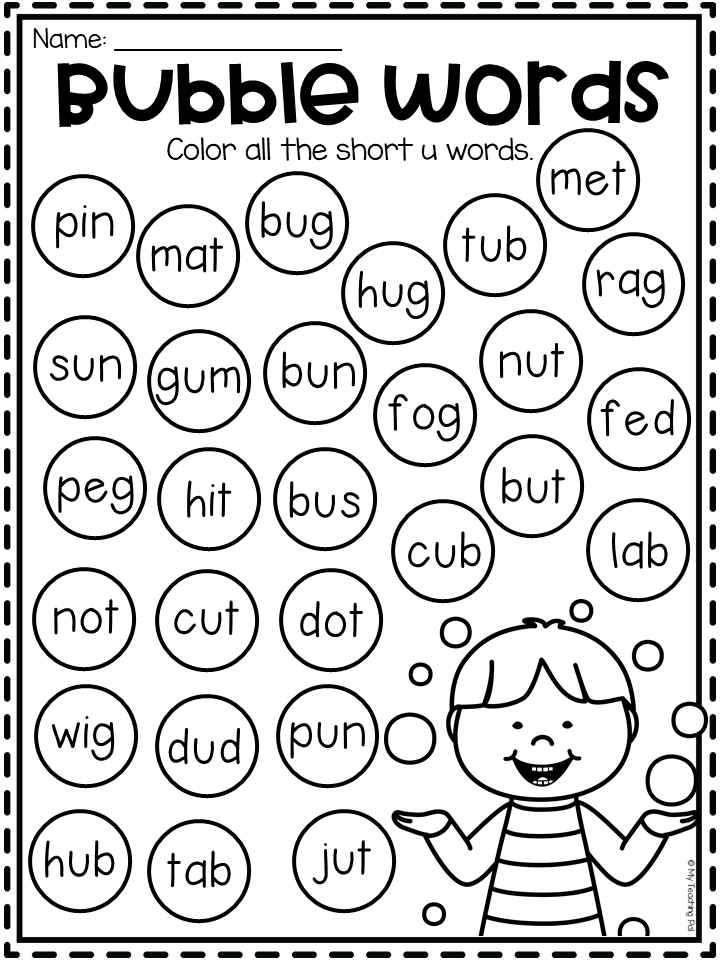 The first step in mastering the various vowel sounds is learning the difference between short vowels and long vowels. Of the two, the long vowels are easier for children to learn because long vowels basically sound the same as the letter names. For example, long a sounds like the a in able, long o sounds like the o in over, and long u may sound like the u in use or the u in blue. Children generally find it more challenging to learn the short vowel sounds because many of them sound so similar to each other: The short i in pig sounds very similar to the short e in peg. The short o in pop sounds a lot like the short u in pup. Before children can learn the rules for spelling and reading short and long vowel sounds, they must be able to recognize and produce these sounds reliably.
The first step in mastering the various vowel sounds is learning the difference between short vowels and long vowels. Of the two, the long vowels are easier for children to learn because long vowels basically sound the same as the letter names. For example, long a sounds like the a in able, long o sounds like the o in over, and long u may sound like the u in use or the u in blue. Children generally find it more challenging to learn the short vowel sounds because many of them sound so similar to each other: The short i in pig sounds very similar to the short e in peg. The short o in pop sounds a lot like the short u in pup. Before children can learn the rules for spelling and reading short and long vowel sounds, they must be able to recognize and produce these sounds reliably. The short vowels can represented by a curved symbol above the vowel: ă, ĕ, ĭ, ŏ, ŭ. The long vowels can be represented by a horizontal line above the vowel: ā, ē, ī, ō, ū. Here are some examples of short vowel words: at, egg, it, ox, up. Here are some examples of long vowel words: ate, each, ice, oak, use. When students have learned to recognize the vowel sounds in Oh, Do You Know?, they can learn short vowel spelling patterns through the Volume 1 song Spelling Families. Long vowel spelling patterns are covered in the Volume 1 songs Talking and Walking and Silent E. Some other songs that teach students about vowel spelling patterns are the Volume 2 songs, Spelling Choices, Cool Vowels, The Right Diphthong, and I Before E, and the Volume 3 songs Why Does Y? and Drop It!.
The short vowels can represented by a curved symbol above the vowel: ă, ĕ, ĭ, ŏ, ŭ. The long vowels can be represented by a horizontal line above the vowel: ā, ē, ī, ō, ū. Here are some examples of short vowel words: at, egg, it, ox, up. Here are some examples of long vowel words: ate, each, ice, oak, use. When students have learned to recognize the vowel sounds in Oh, Do You Know?, they can learn short vowel spelling patterns through the Volume 1 song Spelling Families. Long vowel spelling patterns are covered in the Volume 1 songs Talking and Walking and Silent E. Some other songs that teach students about vowel spelling patterns are the Volume 2 songs, Spelling Choices, Cool Vowels, The Right Diphthong, and I Before E, and the Volume 3 songs Why Does Y? and Drop It!.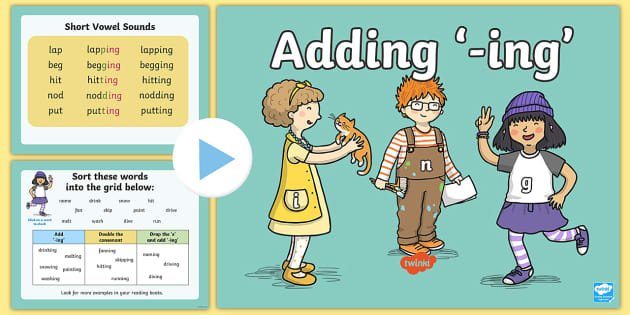
Materials:
- Sing Your Way Through Phonics Volume 1 CD, Tracks 9 and 10 (Listen to audio sample)
- Sing Your Way Through Phonics Volume 1 Mini-Charts (pp. 41-46)
- Letter cards for a, e, i, o, and u.
- Chart displaying long vowel words and pictures (ex. ape, eagle, ice cream, ocean, unicorn)
- Chart displaying short vowel symbols, words and pictures (ex. alligator, eggs, iguana, octopus, umbrella)
- Optional: Cards with medial-position short vowel pictures (ex. hat, cat, hen, pen, fish, dish, dog, log, gum, drum)
- Optional: Cards with medial-position long vowel pictures (ex. snake, rake, sheep, sleep, kite, night, goat, coat, flute, suit)
Note: If you do not have the CD or Mini-Charts, you can still teach this short vowels and long vowels lesson plan using the folk tune listed on the Oh, Do You Know? Song Lyrics page.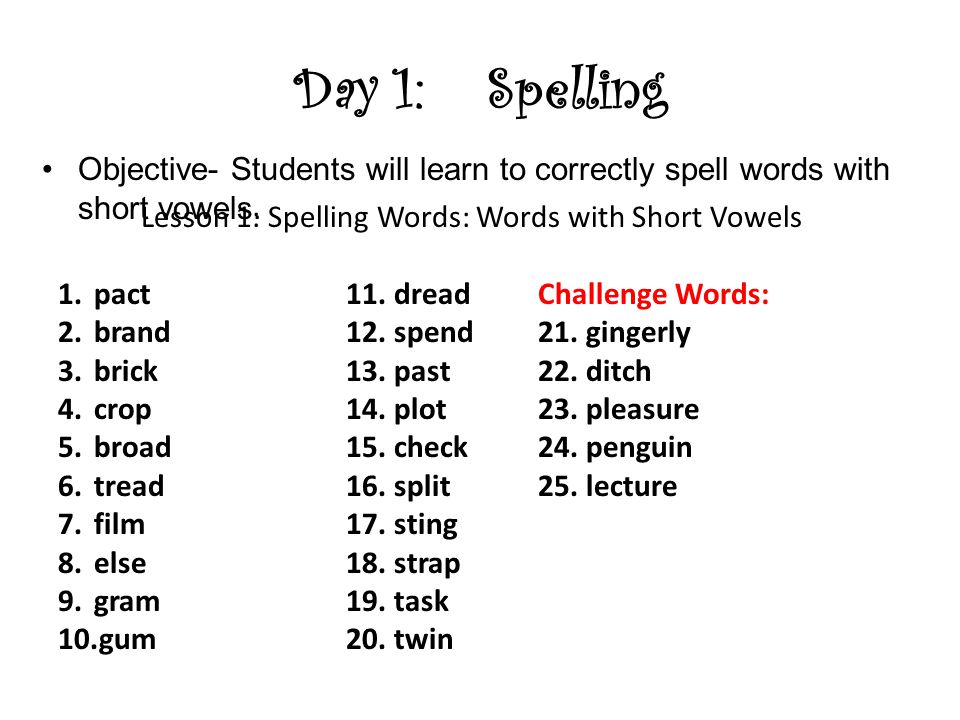 You can create your own mini-charts using the words in bold print letters in each verse of the Song Lyrics.
You can create your own mini-charts using the words in bold print letters in each verse of the Song Lyrics.
Find out more about Sing Your Way Through Phonics products.
Order our cost-saving Volume 1 Combo online.
Procedure:
- Review the letter names of the vowels: a, e, i, o, u, and sometimes y. Say, "Today, we are going to learn about how vowels can sound in words. We will focus on a, e, i, o, and u."
- Display letter cards a, e, i, o, and u. Say, "Sometimes it is easy to hear the vowel in a word. Can you tell me what vowel you hear in the word use (u), in the word eat (e), in the word ape (a), in the word ice (i), in the word oak (o)?" Point to the correct letter card, each time the children answer correctly.
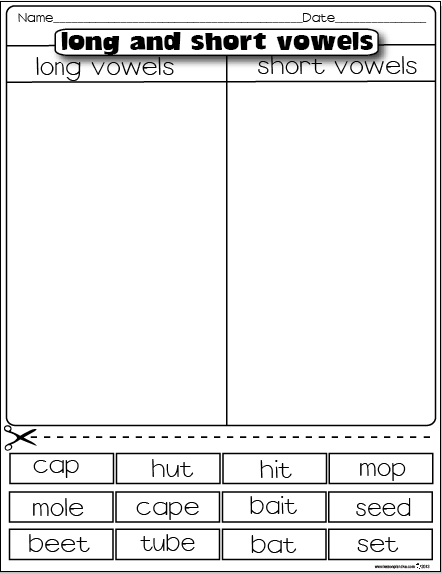 Say, "It is easy to hear the vowels in these words because they actually say their own names. When vowels sound just like their own letter names, we call these long vowels."
Say, "It is easy to hear the vowels in these words because they actually say their own names. When vowels sound just like their own letter names, we call these long vowels." - Display the chart of the long vowels with pictures and symbols. Point to the long vowel chart and say, "We can draw a long line over the vowel if we want to show that it has a long sound. Ask the students to draw this symbol in the air. " Point to ā, and say, "Long a sounds like the beginning of ape." Say together, "Long ē sounds like the beginning of eagle. Long ī sounds like the beginning of ice cream. Long ō sounds like the beginning of ocean. Long ū sounds like the beginning of unicorn."
- Say, "Sometimes a vowel has a different sound and does not say its own name." Show the chart with the short vowel words and pictures.
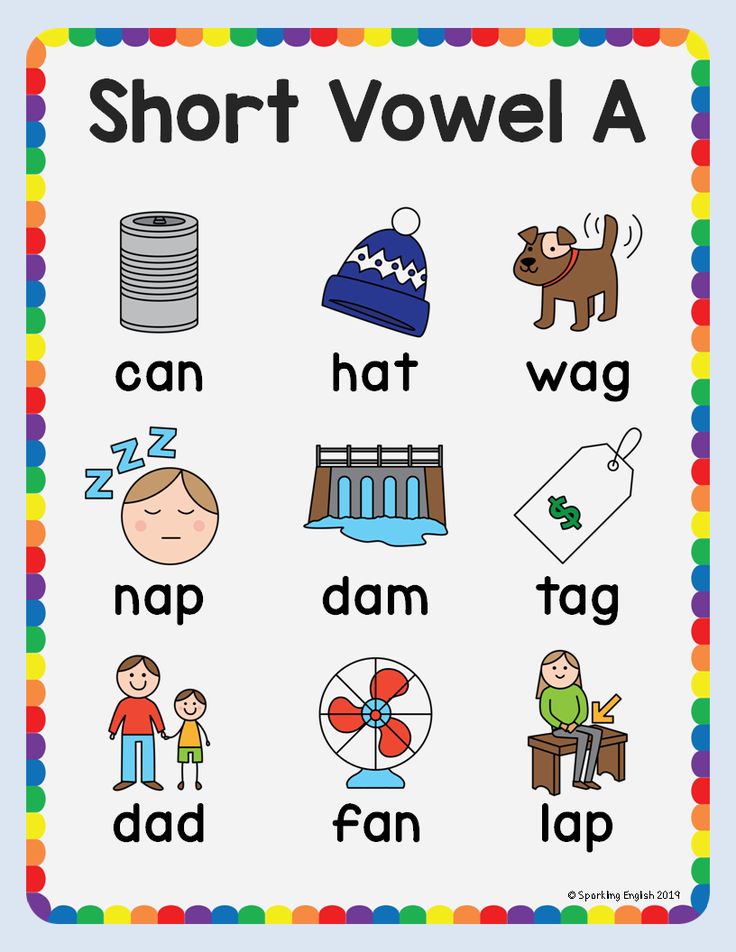 Say, "This chart shows words that have a short vowel sounds."
Say, "This chart shows words that have a short vowel sounds." - Point to the symbols on the short vowel chart and say, "We can draw a short smile over the vowel to show that it has a short sound." Ask the students to draw this symbol in the air. Say, "Let's practice the short vowel sounds saying just the beginning of each word on the chart. Can you say just the beginning of the word alligator? (/ă/), the beginning of the word eggs? (/ĕ/), the beginning of the word iguana? (/ĭ/), the beginning of the word octopus? (/ŏ/), the beginning of the word umbrella?" (/ŭ/)
- Say, “Now we are going to listen to a song about the vowel sounds to help us remember them. At first, the singers will sing about all the short vowel sounds. Next, the singers will sing about all the long vowel sounds.
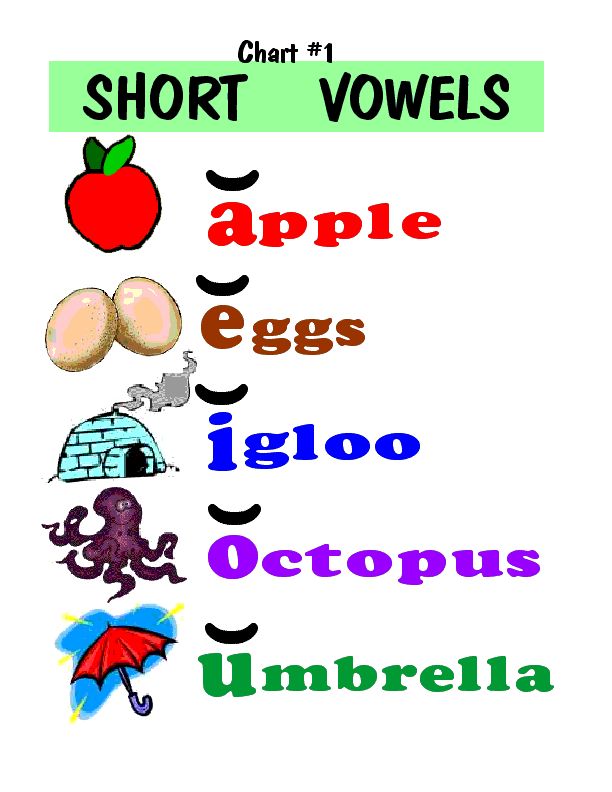 See if you can think the sounds for each vowel before you hear it in the song.” Play Sing Your Way Through Phonics Volume 1 CD, Track 9--Oh, Do You Know? and point to the Mini-Charts on pages 42-46.
See if you can think the sounds for each vowel before you hear it in the song.” Play Sing Your Way Through Phonics Volume 1 CD, Track 9--Oh, Do You Know? and point to the Mini-Charts on pages 42-46. - Point to the symbols on the chart and say, "Did you notice that the short smile and the long line can be written over either capital or lowercase letters? Let's listen to this song again and see if you can answer the singer's questions. Re-play Sing Your Way Through Phonics Volume 1 CD, Track 9--Oh, Do You Know? Students will hear the question, "Oh, do you know the short a sound, the short a sound, the short a sound?" They should sing the answer, "Oh, yes I know the short a sound. The short a sound is /ă/." For the rest of the questions in the song, students should sing the aswers, "The short e sound is /ĕ/.
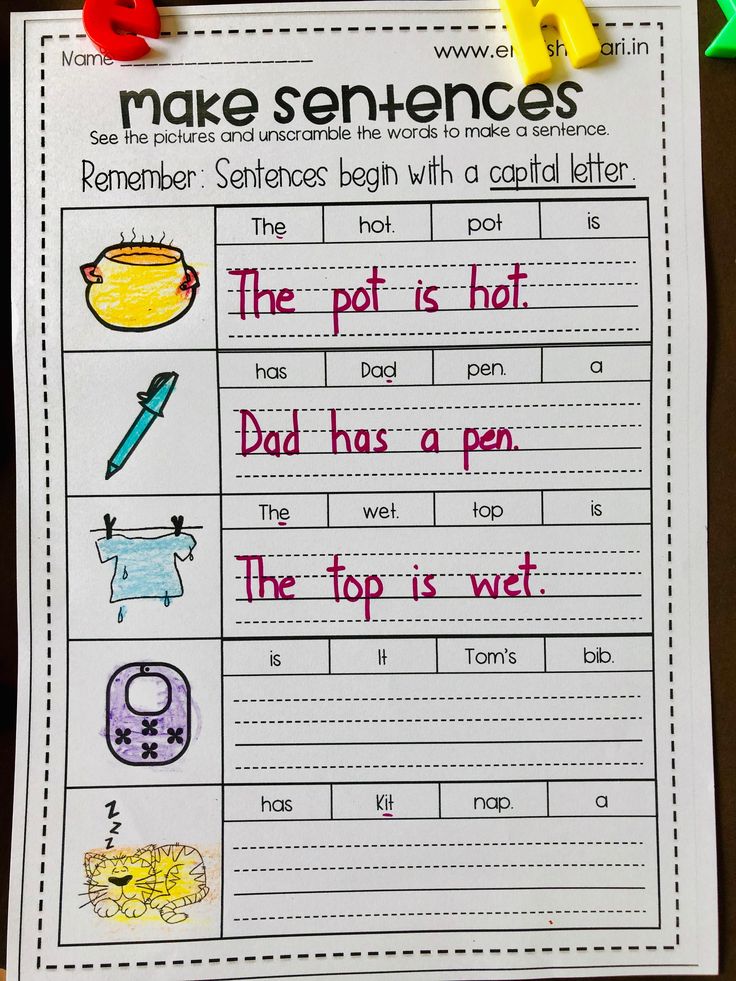 ..The short i sound is /ĭ/...The short o sound is /ŏ/..., The short u sound is /ŭ/..., The long a sound is /ā/..., The long e sound is /ē/..., The long i sound is /ī/..., The long o sound is /ō/..., The long u sound is /ū/." Teachers can point to the children to cue them when it is their turn to answer the song's question.
..The short i sound is /ĭ/...The short o sound is /ŏ/..., The short u sound is /ŭ/..., The long a sound is /ā/..., The long e sound is /ē/..., The long i sound is /ī/..., The long o sound is /ō/..., The long u sound is /ū/." Teachers can point to the children to cue them when it is their turn to answer the song's question. - Listen to the song again, but this time assign a part of the class to sing the song's questions and a part of the class to sing the song's answers. Then switch roles singing questions and answers. Variations: The teacher sings the questions and students sing the answers or vice versa. A small group of students sing the questions and the rest of the class sings the answers or vice versa.
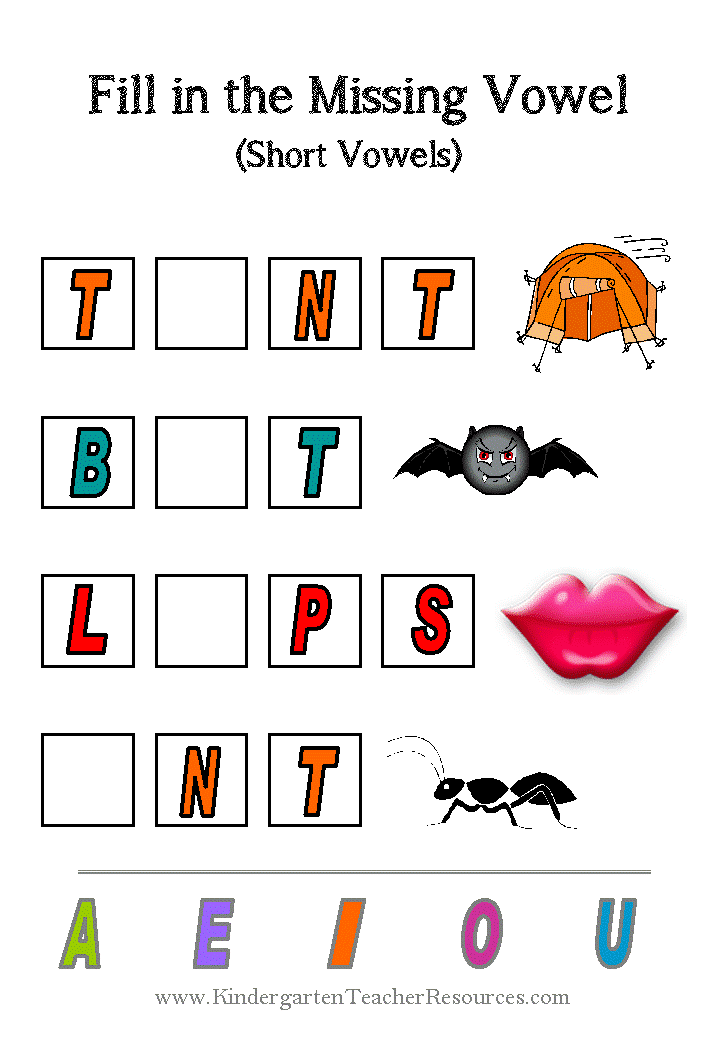 Those singing the answers can write the appropriate symbols in the air or make large symbols with their arm positions as they sing the short or long sounds. Examples: Hold arms out to the sides arching upward for short vowels. Hold arms straight out to the sides for long vowels.
Those singing the answers can write the appropriate symbols in the air or make large symbols with their arm positions as they sing the short or long sounds. Examples: Hold arms out to the sides arching upward for short vowels. Hold arms straight out to the sides for long vowels.
Follow-up:
- Practice singing Oh, Do You Know daily for a few days. Then try singing the song without hearing the words, using the instrumental track (Track 10). Allow different students to point to the Mini-Charts words while singing.
- Using the Mini-Chart Templates, vary the order of vowels (Ex:short i, short a, short u, short e, short o) or vary short and long vowels in sequence (Ex: short a, long a, short e, long e, etc.)
- As a learning center task, have students match pairs of picture cards with the same vowel sounds (Ex: cat/hat, snake/rake).
 Note: At this point in their learning, it is easier for children to do this task if rhyming words are used. As they advance, they may be able to match short common vowels in pictures of non-rhyming words such as bag and bat.
Note: At this point in their learning, it is easier for children to do this task if rhyming words are used. As they advance, they may be able to match short common vowels in pictures of non-rhyming words such as bag and bat.
Extensions:
- Introduce the Read-and-Sing Book, Oh, Do You Know?. The comical illustrations provide several examples of each sound in the song. When children sing, "Oh, do you know the short a sound?", they can point to cats, apples, ants, an ax, a hat, and a basket. For long a, they will find Amos listening to the radio, holding a May calendar next to a table with cake, maple syrup, grapes, and plates. After children can remember all the vowel sounds, they can sing on their own with the instrumental version of the song and perhaps create their own short and long vowel pictures. They will also enjoy grouping objects that have the same vowel sounds or creating collages of magazine cut-outs.
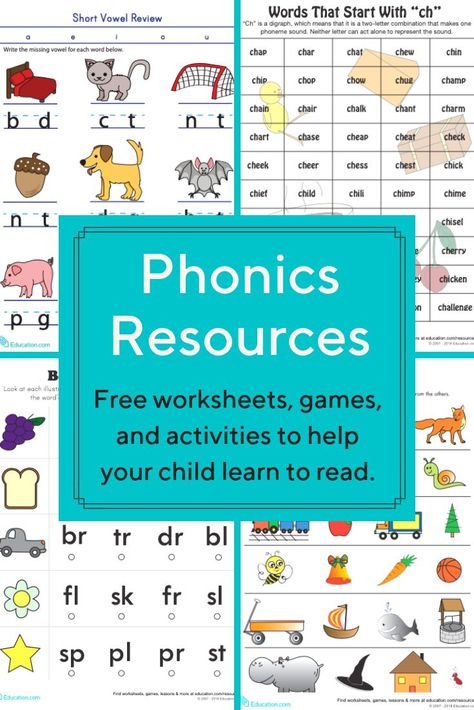 Keep a few copies of the book at a literacy center equipped with headsets so that students can gain practice in listening, singing, and remembering the sounds of the long and short vowels.
Keep a few copies of the book at a literacy center equipped with headsets so that students can gain practice in listening, singing, and remembering the sounds of the long and short vowels. - Using 3-letter or 4-letter words, explain the rule that when one vowel is in the middle of a word, it is usually short (Ex. bag, sit, bed). Print some of these words on a word wall. Pointing to an appropriate word, perform this rap to reinforce the short vowel rule: "Got one vowel in the middle of the word, got one vowel in the middle of the word, got one vowel in the middle of the word--Say /ă/, say /ă/, say /ă/ [clap-clap]. Repeat by pointing to another appropriate word and another short vowel sound until all short vowel sounds have been covered. Variations: Add back and forth side-steps while reciting the rap. Change the ending claps to taps, stomps, or knocks. Add rhythm instruments to help keep the beat.
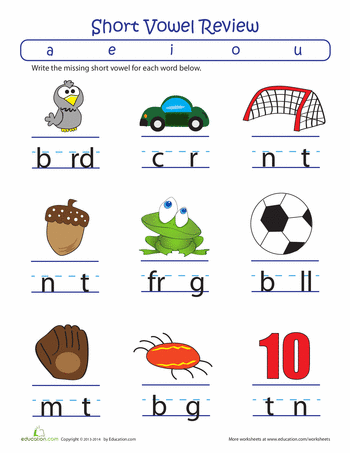
- Find short vowel words in children's books and poems. Examples: From Shel Silverstein's Poetry in Where the Sidewalk Ends-Ickle Me, Pickle Me, Tickle Me, Too for short i; Jimmy Jet and his TV Set for short e. Singing games like The Banana Song (using the name Anna). Dr. Seuss' There's a Wocket in my Pocket and Fox in Sox for short o. Nursery Rhymes like Jack Sprat for short a; Diddle Diddle Dumpling for short i, short u, short o, and short e; Hickety-Pickety for short i and short e.
- Find short and long vowel sounds in students' names. Ex. Ann, Ellen, Jim, John, Buddy for short vowels; Jake, Steve, Mike, Joan, and Judy for long vowels.
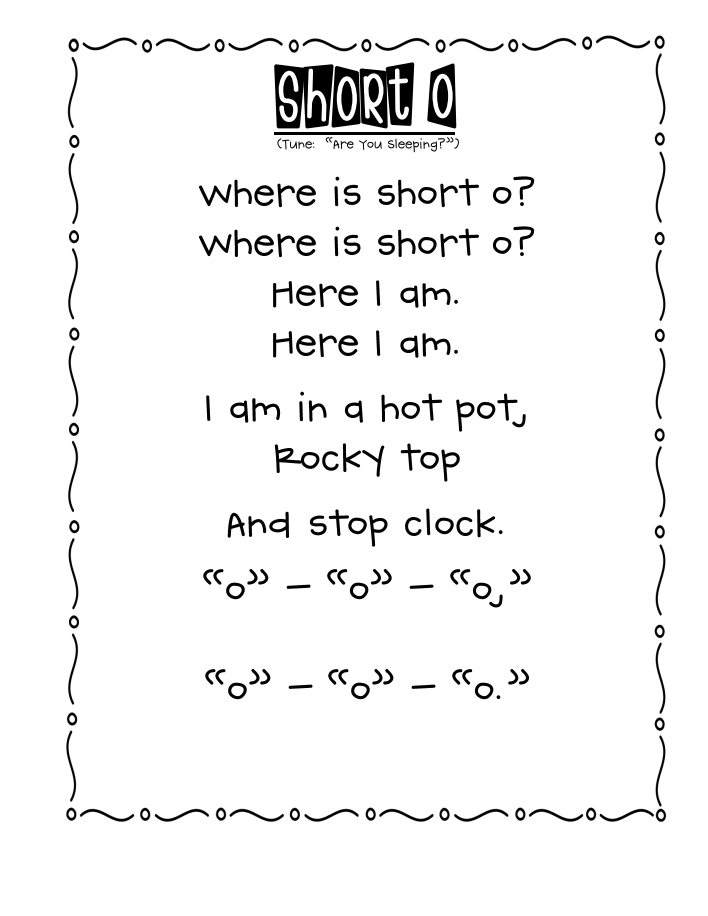
- Find short and long vowel sounds in environmental words like Exit, Stop, Bus, In. Label classroom objects that illustrate short and long vowel sounds: dĕsk, chāir, tāble, gāme, pĕncils, pĕns, pāper, shĕlf, răck, lĕdge, ēasel.
- Have a Show-and-Tell time where children bring in objects with a particular short or long vowel sound. Place these or other objects on a table labeled with that vowel and the short or long symbol.
Evaluation:
- Students can produce the correct short vowel and long vowel sounds on Mini-Charts pp.41-46 without assistance.
- Students pass a written or manipulative test where they match pairs of short vowel pictures and long vowel pictures.
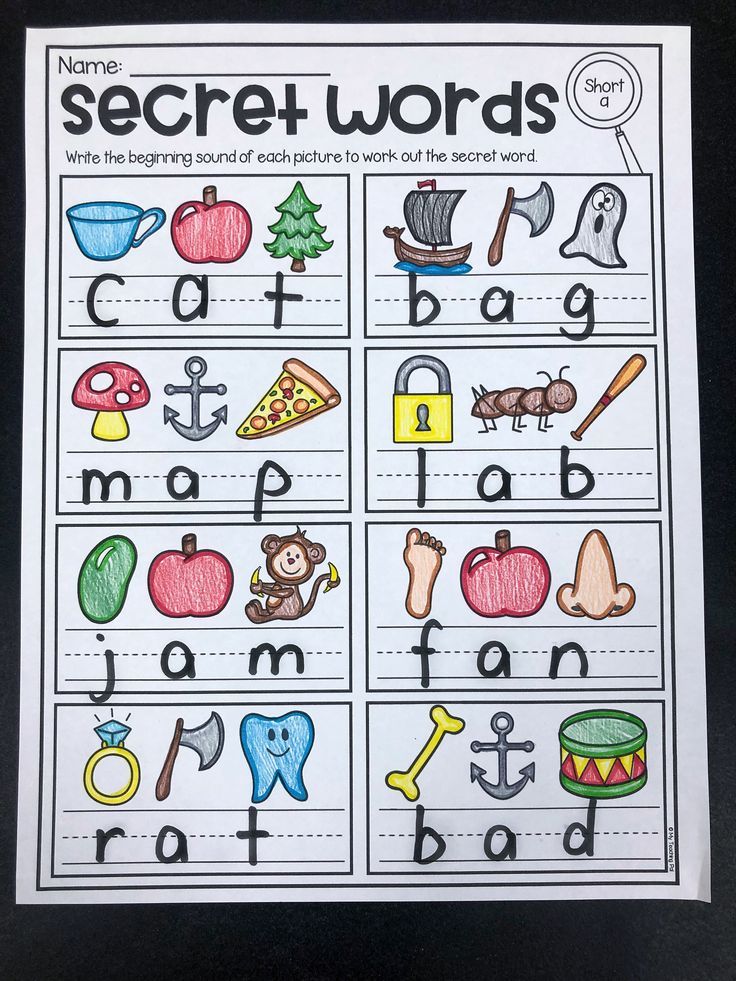
Order our cost-saving Sing Your Way Through Phonics Volume 1 Combo online ($33.95) containing the CD, Mini-Charts, Song Lyrics, and Teaching Suggestions — everything you need for this lesson! Or, print out an order form to mail/FAX to us.
Lesson 1: Vowels similar to Russian AND
First of all, let's deal with the sounds that we associate with our sound "and". There are two and a half such sounds in English - [ ɪ ], [ iː ] and [ i ]. “With a half”, because the short sound [ i ] is not distinguished by a separate sound in all dictionaries (that is, this sound differs insignificantly), and besides, it occurs mainly either at the end of the word (“happy” - [ ˈhæpi ]), or at the end of a syllable before another vowel (“alien” - [ ˈeɪ.li.ən] ). The main thing for us is to understand the difference between [ ɪ ] and [ iː ].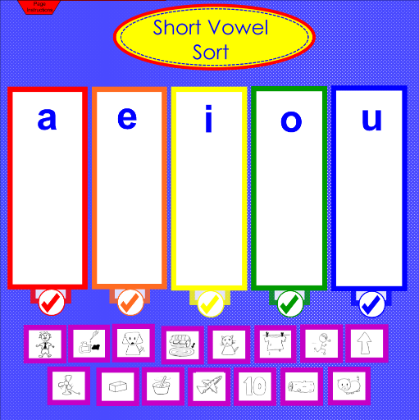
The fundamental difference between the pronunciation of the Russian “and” and the English sounds [ ɪ ] and [ iː ], oddly enough, is easiest to understand by paying attention to other sounds, namely, to the consonant sounds in front of them. We clearly know that in Russian the consonants before “i” are pronounced softly (with the exception of the always hard “zh” and “sh”). There is no such softening of consonants (palatalization) in English. Instead of pairs of hard and soft consonants, we have something neutral. A necessary condition for palatalization is an elevated position of the tongue, which, as we have said before, is uncharacteristic of English speech.
If we forget about this fundamental difference and keep the Russian “and” in mind, we automatically get an elevated tongue and two sounds that are incorrectly pronounced in a syllable at once (a vowel and a consonant preceding it). Therefore, as with most English sounds, everything starts from the correct starting position, i.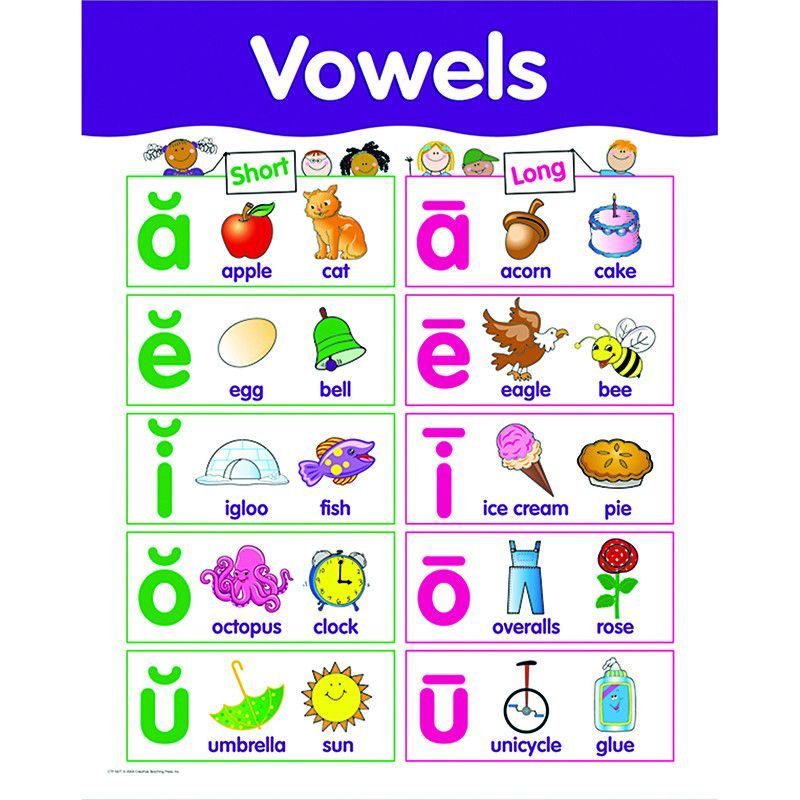 e. the back half of the tongue is pressed down to the lower jaw, flattened and rests on the sides against the molars.
e. the back half of the tongue is pressed down to the lower jaw, flattened and rests on the sides against the molars.
[
ɪ ] - kit, spotted, sit Let's start with a short sound [ ɪ ]. When communicating with the British, it immediately struck me ... in my ear (?) :) that for our hearing the sound [ ɪ ] sounds closer to “e” or “e” than to “i”. That is, rather "ofes" than "office" ("office") or "larex" instead of "lyrics" ("lyrics"). What needs to be done to make this vowel sound with the same quality?
- First of all, get ready to say our "e" sound, only slightly covered, as we sometimes say in the phrase "all of these."
- Now, without changing the position of the speech apparatus, instead of "e" say "s". Your "y" should have a similar feeling of "covering up". Keep in mind that this is a short, relaxed vowel, so don't try to drag it out.
- Finally, remember the root of the tongue, press it down and try to pronounce the same sound again.
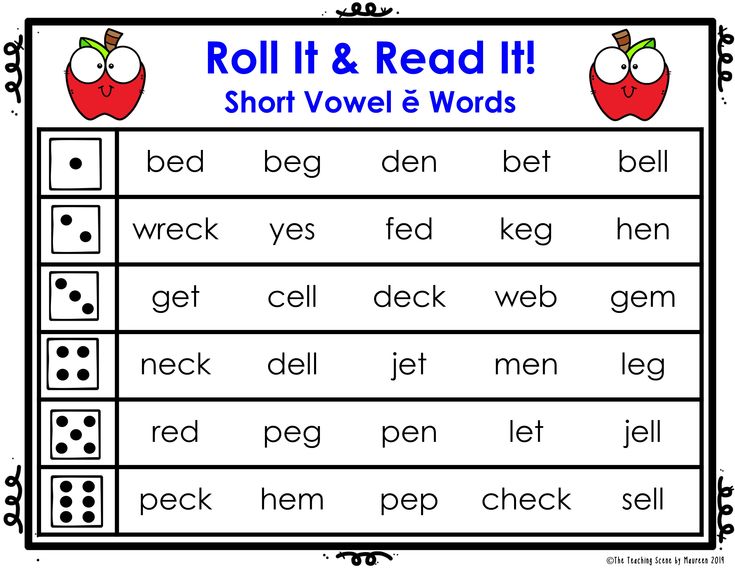 Unlike the Russian “y” sound, which resonates in the back of the mouth, in this step you should feel your sound resonate in front, almost at the level of the front teeth.
Unlike the Russian “y” sound, which resonates in the back of the mouth, in this step you should feel your sound resonate in front, almost at the level of the front teeth.
At first, you can do it directly in three steps: covered "e" - "s" - the root of the tongue. And follow the feelings. In the end, you will clearly catch the peculiarity of the pronunciation of this sound. This may not happen immediately, because. the tongue, like any other muscle, takes time to learn a new position. But it is very important to understand how to pronounce this sound correctly. First, you will automatically have most of the difficulty in pronouncing the consonants that precede this sound. To do this, it is enough to “prepare” to pronounce the vowel sound, in accordance with what is described above, before pronouncing the leading consonant. Second, master the long [ iː ] then it will be much easier for you. Thirdly, having dealt with [ ɪ ], you will lay a solid foundation for mastering diphthongs (double vowels) in which the sound [ ɪ ] is involved.
[
iː ] — fleece, see, meat considered. The difference is that when pronouncing long sounds, which are also called “tense” (as opposed to relaxed short ones), the root and middle of the tongue are stretched, creating a feeling of tension. Most importantly, make sure that the tongue remains flat and in no case arches towards the palate, as with the Russian “and”. Such stretching occurs gradually, starting from a completely relaxed root of the tongue (as with a short [ ɪ ]). To illustrate this, Russian-speaking students are sometimes asked to pronounce this sound, stretching from "s" to "i". Please note that we do not draw this vowel on purpose. It's just that stretching takes time, and therefore the sound is longer.
Be sure to listen to how these two sounds are pronounced in comparison in electronic dictionaries, at least in the same Lingvo Live. I can offer you several word pairs:
- Ship - sheep
- Bit-beat
- Live - leave
And a couple more examples.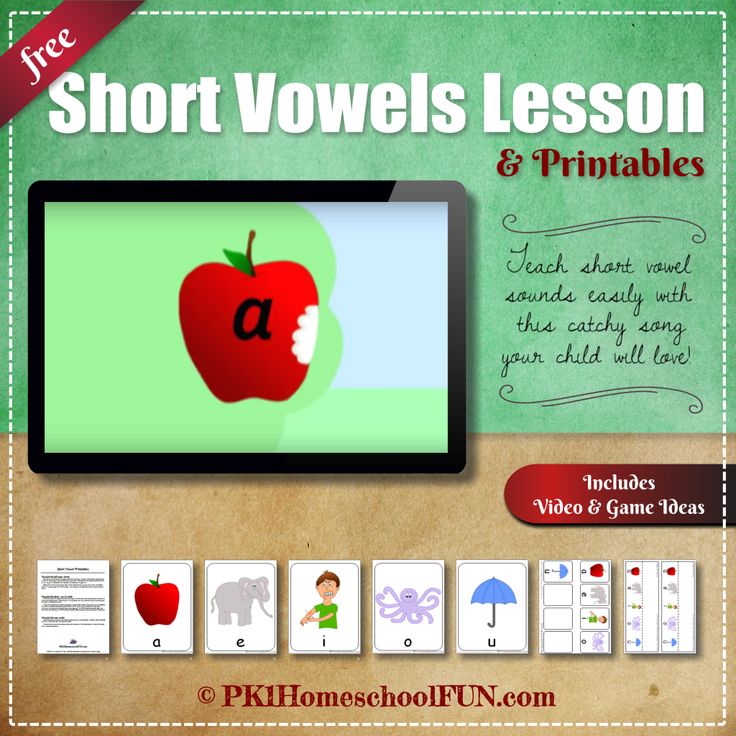 You definitely do not want to confuse them in a conversation with a decent Englishman.
You definitely do not want to confuse them in a conversation with a decent Englishman.
- Piss-peace
- Shit-sheet
[
i ] - happy, city Although both vowels are short, in the second case some qualitative difference is implied between the vowels in the first and second syllables. If you like, you can think of this sound as a long [ iː ], pronounced shorter than usual, due to which the root of the tongue does not have time to fully tighten. In fact, this nuance is so insignificant that it is not worth worrying about it.
In the next lesson, we will look at vowels similar to the Russian "A".
English transcription lessons
English transcription - lesson 4 - English from scratch
From the previous lessons you learned that there are more than 40 sounds in the English language, and only 26 letters. Such a variety of sounds provokes the difference between the spelling of words and their pronunciation.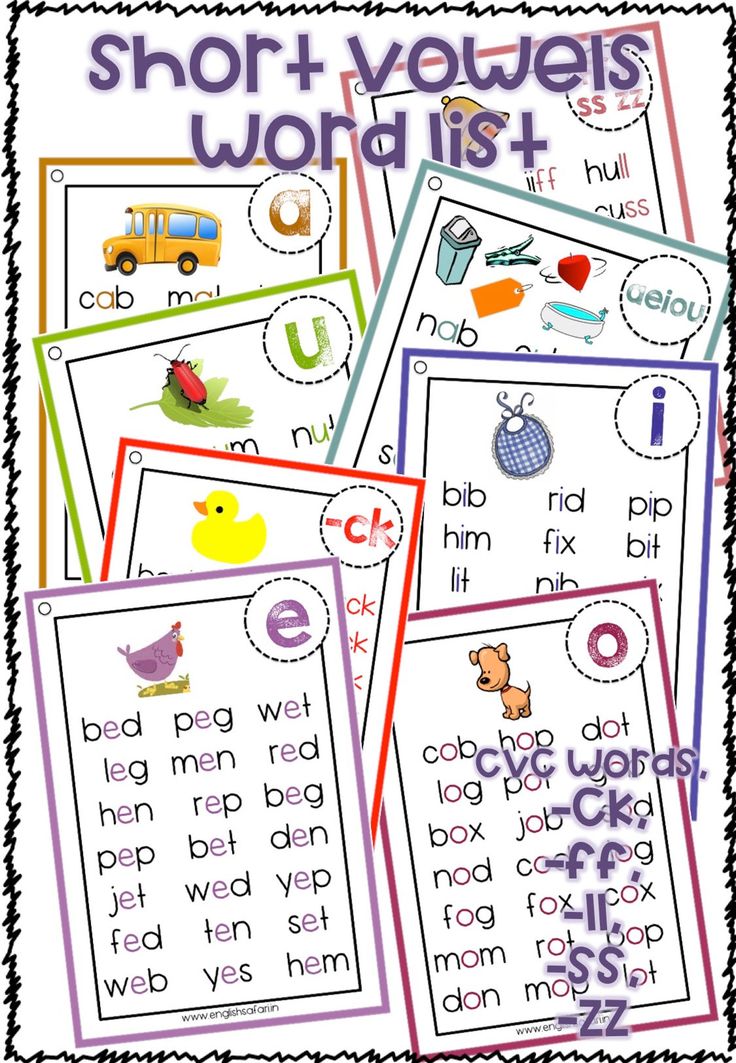 Therefore, a system of phonetic signs was invented, which helps to accurately convey the pronunciation of words. This system is called transcription of English sounds.
Therefore, a system of phonetic signs was invented, which helps to accurately convey the pronunciation of words. This system is called transcription of English sounds.
In the previous lessons, vowels and consonants were considered, and now you need to work on sounds and learn how to write them in the form of letters or letter combinations.
Also take a look at our dedicated section on sounds on our website, where each sound is examined in more detail and accompanied by a video with a native English speaker. Below, when considering sounds, there are links by which you can go to an article on each sound and learn more about the features of its pronunciation.
Vowel sounds
Vowel sounds are divided into long, short and diphthongs. Consider their pronunciation and how they are transmitted in writing:
- The sound [i:] is long and pronounced with a wide smile. Transmitted in writing:
- The letter Her in an open syllable: she [ʃi:] - she, evening [i: vniɳ] - evening.
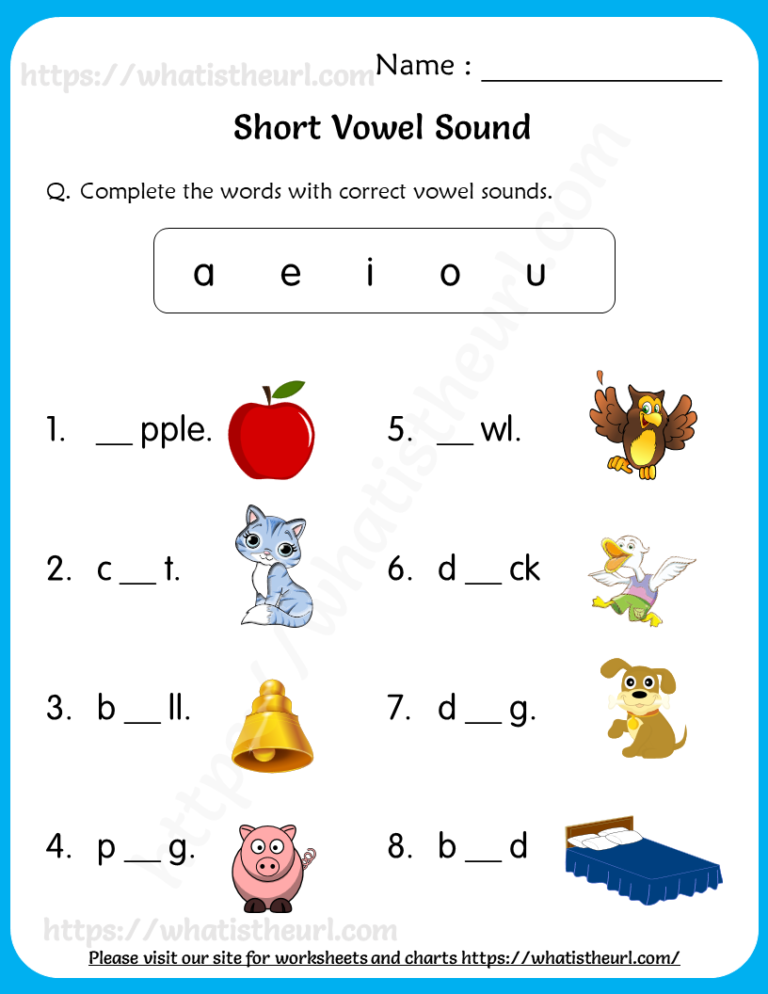
- Her letter combination: free [fri:] - free, week [wi: k] - week.
- Letter combination ea: dream [dri: m] - to dream, tea [ti:] - tea.
- The letter Her in an open syllable: she [ʃi:] - she, evening [i: vniɳ] - evening.
- Sound [ɪ] - short, middle between Russian sounds [i] - [s]. On the letter it is:
- Letter Ii in a closed syllable: ticket [tikit] - ticket, with [wiꝺ] - p. Or in exception words in an open syllable: river [rivə] - river, city [siti] - city.
- Letter Yy at the end of words: many [mᴂni] - many, sunny [sʌni] - sunny.
- The sound [e] is short, similar in pronunciation to the sounds [e] and [e]. The letter conveys:
- Letter Ee in a closed syllable: ten [ten] - ten, pen [pen] - pen.
- The letter combination ea in some words: head [hed] - head, bread [bred] - bread.
- Sound [ᴂ], middle between sounds [e] and [a]. It must be pronounced correctly, and not replaced by the sound [e]. On the letter:
- Letter Aa in a closed syllable: bad [bᴂd] - bad, rabbit [rᴂbit] - rabbit.
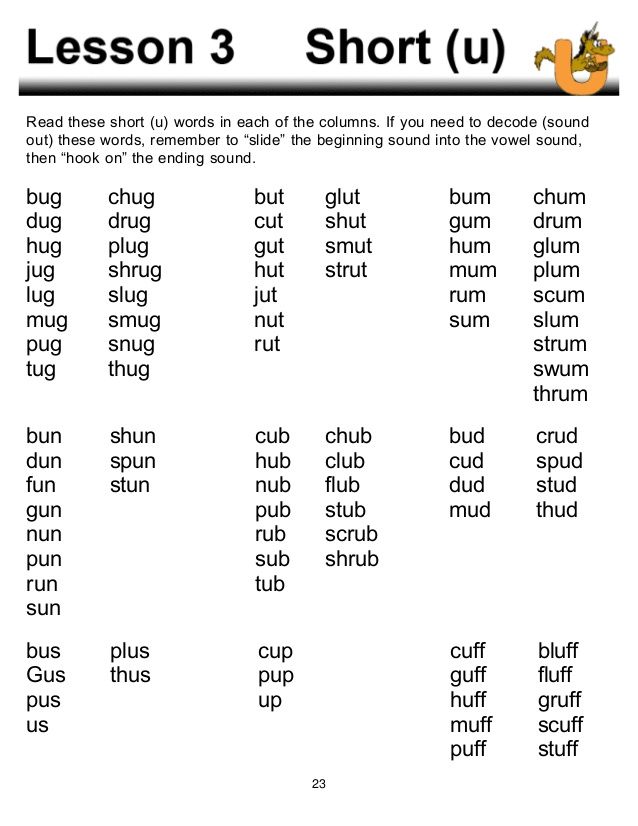 And in some exception words, in an open syllable: have [hᴂv] - to have.
And in some exception words, in an open syllable: have [hᴂv] - to have.
- Letter Aa in a closed syllable: bad [bᴂd] - bad, rabbit [rᴂbit] - rabbit.
- The sound [a:] is long, similar to the Russian sound [a]. Transmitted by letter with:
- Letter combinations ar: far [fa:] - far, dark [da:k] - dark.
- Letters Aa in some words: father [fa:ꝺə] – father.
- Sound [ɒ] - short, written in writing:
- The letter Oo in a closed syllable: top [tɒp] - top, frog [frɒg] - frog.
- The letter Aa in some words: was [wɒz] - was, watch [wɒtʃ] - watch.
- The sound [ɔ:] is long. Transmitted in writing:
- Letter combination or: short [ʃɔ:t] - short, order [ɔ:də] - order.
- The use of the letter Aa before Ll: fall [fɔ: l] - fall, ball [bɔ: l] - ball.
- The combination of letters au: Australia [ɔ: strᴂlia] - Australia, audio [ɔ: diɒ] - audio.
- The sound [u] is similar to Russian [y] and is transmitted using:
- Letter combinations oo: mood [mud] - mood, book [buk] - book.
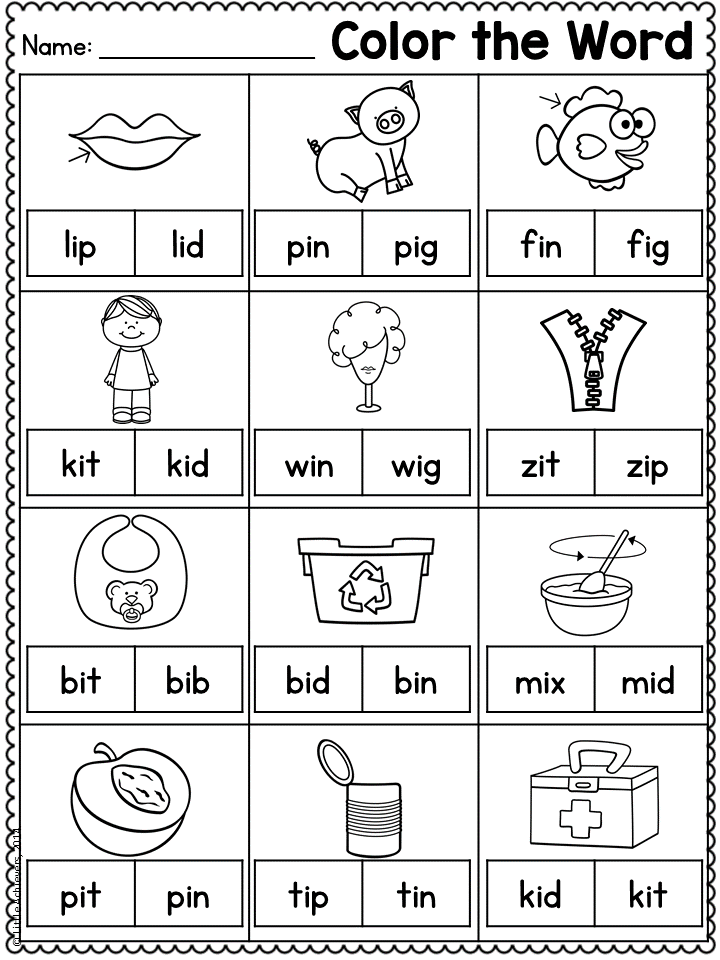
- The letters Uu in a closed syllable, in some words: put [put] - put, pull [pul] - pull.
- Letter combinations oo: mood [mud] - mood, book [buk] - book.
- The [u:] sound is long. On the letter it is:
- Letter combination oo: school [sku: l] - school, spoon [spu: n] - spoon.
- The letter Oo in some words: who [hu:] - who, move [mu: v] - move.
- The letter Uu in some words: blue [blu:] - blue.
- The sound [ju:] is long and similar to Russian [yu]. In writing, this could be:
- The letter Uu in an open syllable: use [ju:z] - use, tube [tju:b] - pipe.
- Letter combination ew: few [fju:] - a little, new [nju:] - new.
- The sound [ʌ] is short, like Russian [a], but it is pronounced shorter. On the letter:
- Letter Uu in closed syllable: bus [bʌs] - bus.
- The letter Oo in some words: son [sʌn] - son.
- The letter combination ou: trouble [trʌbl] is a problem.
- The sound [ɜ:] is long, it is a cross between [e] and [o].
 On the letter it is:
On the letter it is: - Letter combinations er, ir, ur, or: servise [sɜ:vis] - service, stern [stɜ:n] - strict, fur [fɜ:] - wool, work [wɜ:k] - work.
- The sound [ə] is similar to the previous one, but much shorter and not pronounced clearly. Transmitted by letter combinations er, or, our in an unstressed position.
English transcription provides for the presence of diphthongs, double vowels:
Consonants
Consonants are voiceless and voiced, and form pairs with each other:
Sounds in English and their pronunciation is 9002 the sound of a letter or word as a sequence of special phonetic characters, i.e. the sounds of the English language.
There are 44 sounds in English, 20 of which are vowels and 24 consonants.
Vowels. There are 20 vowels in English:
7 - short vowels (short vowels)
5 - long vowels (long vowels)
8 - diphthongs / double vowels (diphthongs)
Consonants.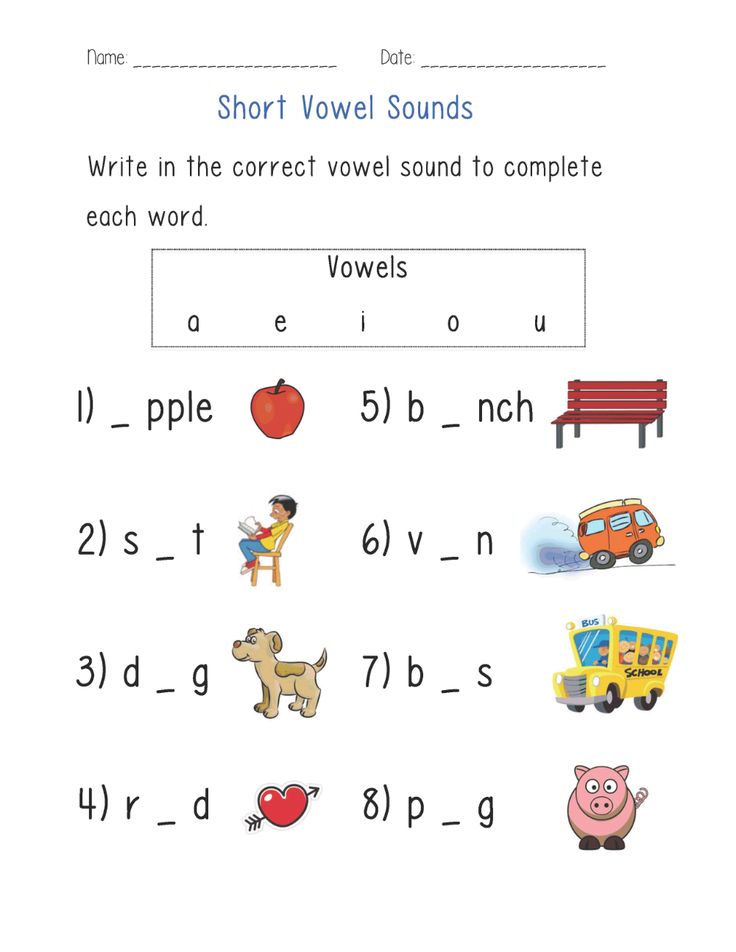 There are 24 consonants in English:
There are 24 consonants in English:
8 - deaf consonants (voiceless consonants)
8 - voiced consonants (voiced consonants)
8 - other consonants
there are always some subtleties in pronunciation. But this is just a matter of practice. A little later, if necessary, you can transcribe the words yourself.
Transcription is directly related to reading rules. In English, not everything that is seen (letter combinations) is read (as in Russian and Spanish, for example).
Table: Transcription of English letters and sounds
Vowel sounds of the English language
The pronunciation of the sounds of the English language is represented by Russian letters, you should understand that it is not possible to convey the correct English pronunciation using the Russian alphabet.
- ɑː long, deep a
- ʌ short vowel a, as in the Russian word run.
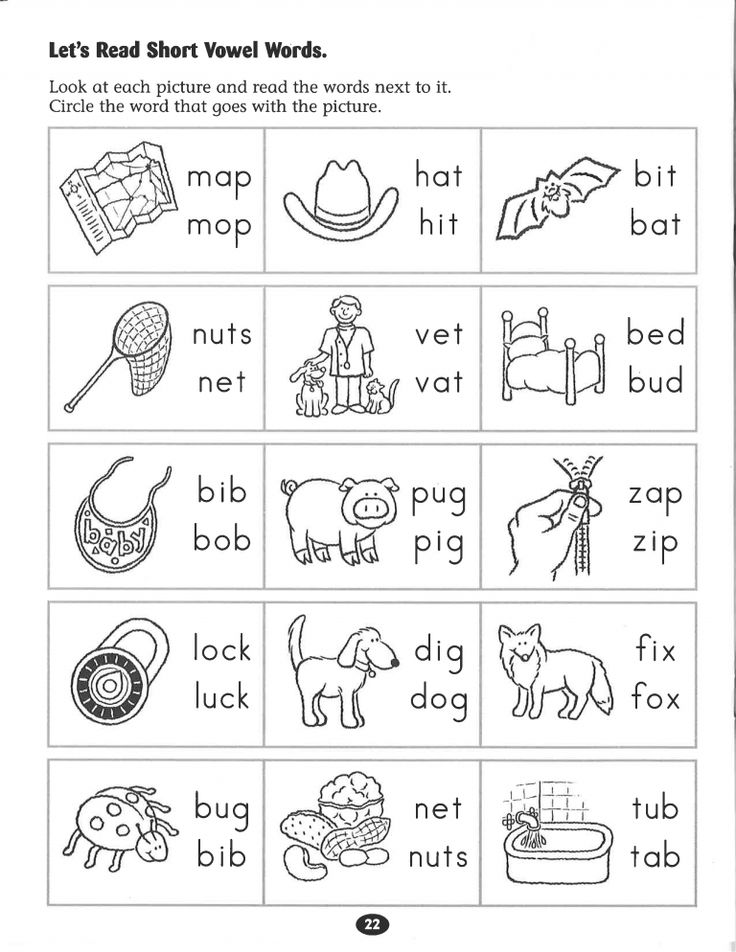
- ɒ = ɔ - short, open about
- ɔː - long about
- зː = əː - a long vowel ё, as in the Russian word hedgehog.
- æ - open e
- e - like e in the word these
- ə - unclear unstressed sound, similar to e
- iː - long and
- ɪ - short, open and
- ʊ = u - short y pronounced with a slight rounding of the lips.
- uː - long y pronounced without strong rounding of the lips.
Lesson 2: English transcription (part 1)
This topic is very important in the English language and must be learned for further study. And since this topic is very voluminous, we will break it into two lessons. In this lesson, we will get acquainted with short vowels, and some of the consonants that are closest to the corresponding Russian sounds.
Although, as you have seen, there are fewer letters in English than in Russian, but there are much more sounds - 44 sounds. Of these, 20 are vowels and 24 are consonants. Now remember that there are only 6 vowels in the English alphabet and correlate them with twenty sounds, and it should immediately be clear to you that when studying words, you need to learn not only the spelling of the word itself, but also its transcription. Many people skip the topic of transcription by simply reading it fluently, but this is a very big mistake, because by remembering the transcription notation, you will be able to memorize words with the correct pronunciation - by ear, we cannot always determine which sound was pronounced (especially at the beginning of learning), and also, no one has canceled the visual memory that will appear before your eyes when you pronounce this or that word. And it’s bad when you enter a word with the wrong pronunciation in your memory - it will take you much more time to relearn it. Therefore, learn (memorize) these sounds and periodically repeat them in the dictionary, believe me, this will help you a lot.
Now remember that there are only 6 vowels in the English alphabet and correlate them with twenty sounds, and it should immediately be clear to you that when studying words, you need to learn not only the spelling of the word itself, but also its transcription. Many people skip the topic of transcription by simply reading it fluently, but this is a very big mistake, because by remembering the transcription notation, you will be able to memorize words with the correct pronunciation - by ear, we cannot always determine which sound was pronounced (especially at the beginning of learning), and also, no one has canceled the visual memory that will appear before your eyes when you pronounce this or that word. And it’s bad when you enter a word with the wrong pronunciation in your memory - it will take you much more time to relearn it. Therefore, learn (memorize) these sounds and periodically repeat them in the dictionary, believe me, this will help you a lot.
When studying transcription sounds, you will be given examples of words with these sounds.